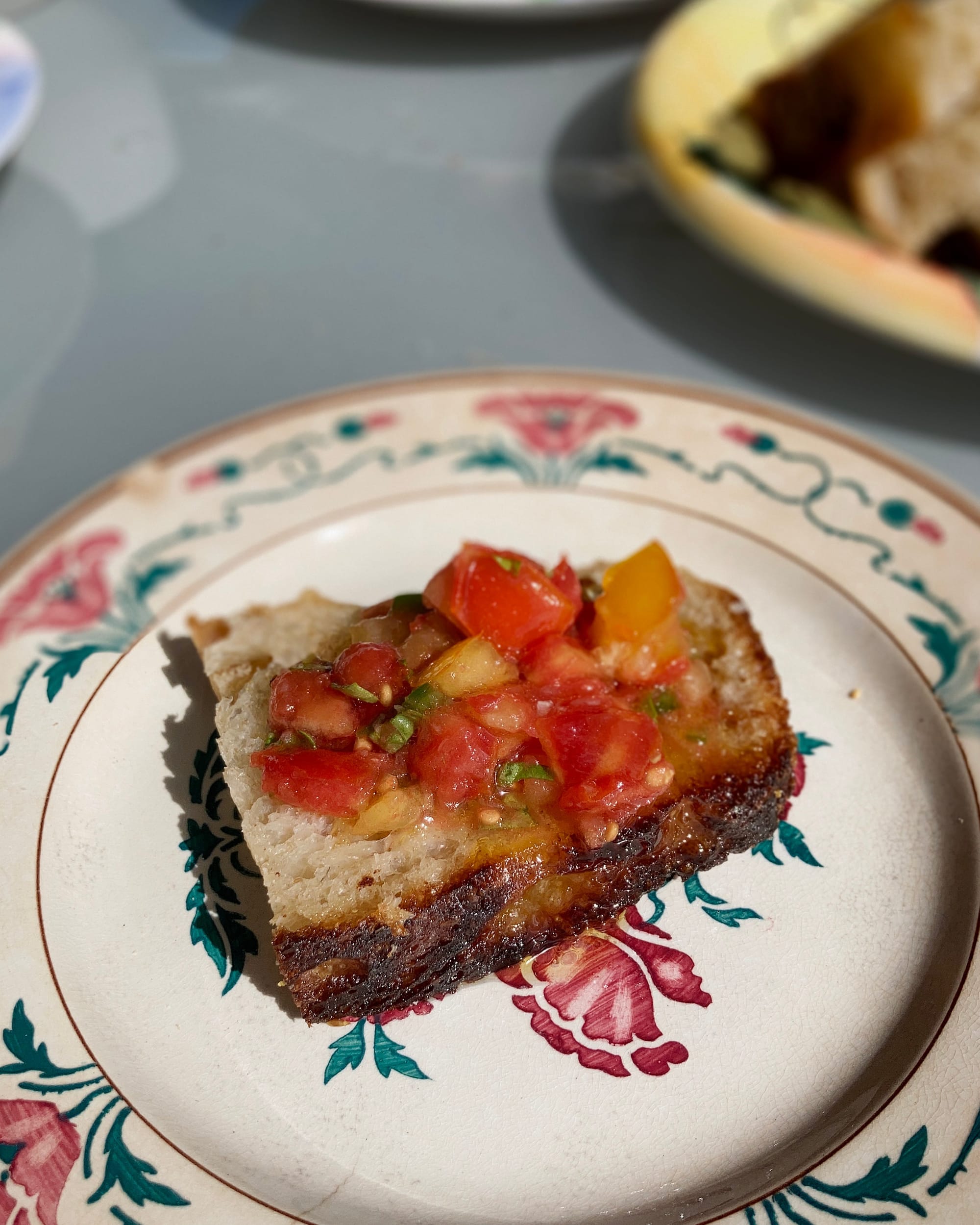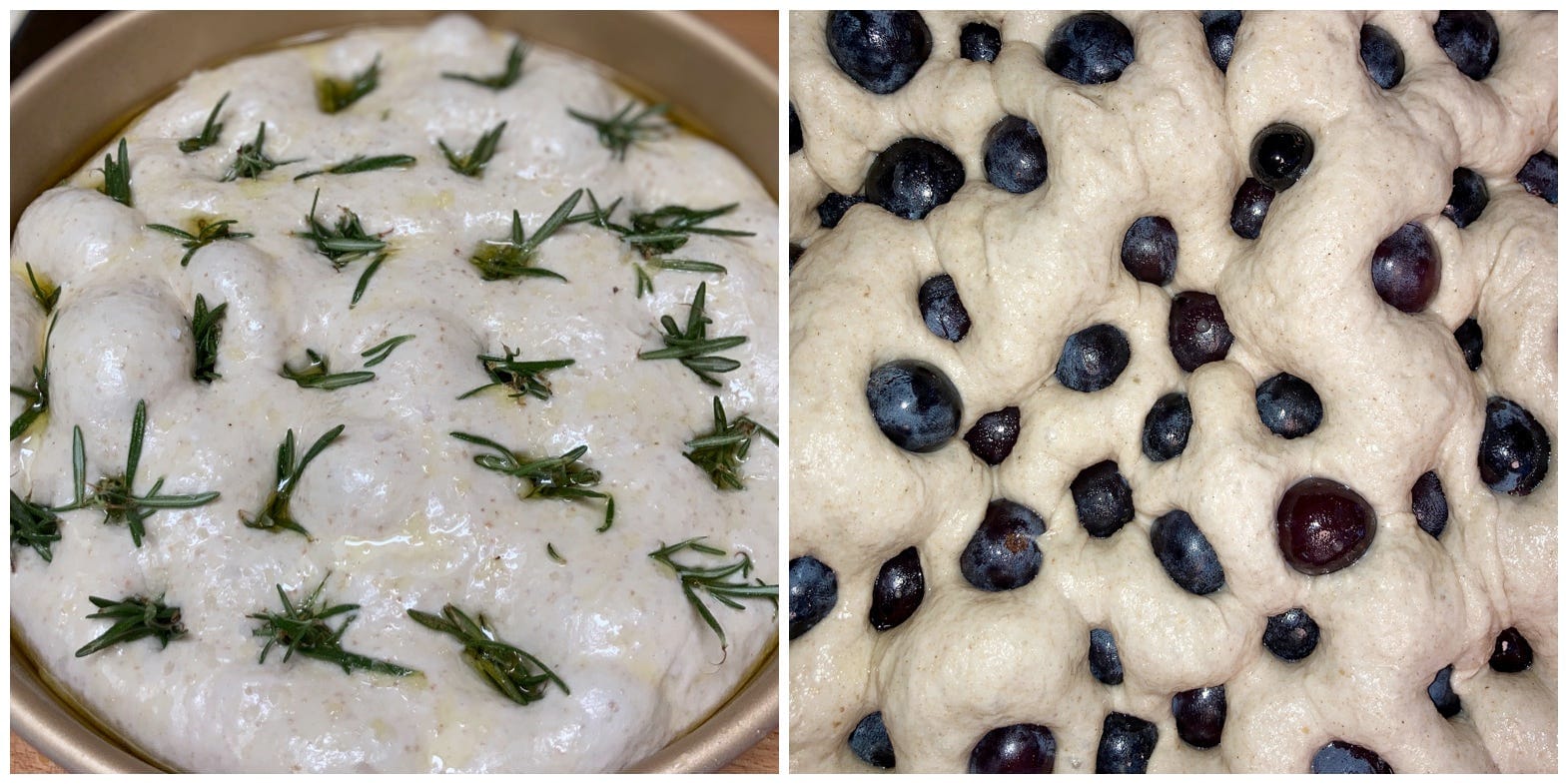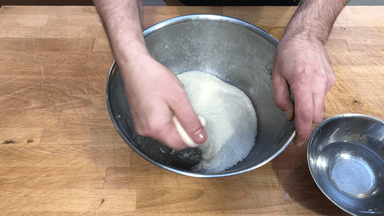Recipe: No Knead Sourdough Focaccia

Today’s recipe—the first since I relaunched!—is for a no-knead sourdough focaccia I have been making a lot lately.
But first, a little bit of housekeeping. I wanted to explain how I hope that readers will interact with this newsletter. For the most part everyone has figured it out on their own intuitively, but occasionally I need to spell it out, so I wanted to do so here so it is clear.
You get the newsletter in your email mailboxes and you can read them on the Substack website. How I’d like you to respond to something you read depends on the nature of the response:
If you have a comment, question, or request of a personal nature—I went to grade school with your Mom! / Can I order dried sourdough starter? / Why are you such a jerk?—please send those by replying to the email directly (unless you really want to hash out my jerkiness in public, in which case by all means leave a comment).
If you have a comment, question, or request that relates to the post itself—Can I use whole wheat flour in place of rye here? / Can you show us how to do step 5 in more detail?/ Did you really mean to write 120g salt?—then please click through to the website and leave a comment. That way everyone can read the response and learn from it. (And others can comment themselves and we can turn Wordloaf into the community I hope it will eventually become.)
As for how to read the posts, particularly when it comes to recipes:
I’m a one-man band here, so as much as try to proofread my work and double check my calculations, mistakes will be made. Please let me know when you see things that are off by leaving a comment, and I will do my best to correct them as soon as possible. Keep in mind that that means the most up-to-date version of any recipe or post is going to be on the website, not in your inbox. Try to click through to the post before starting a recipe, so you are always using the most accurate version.
Enough, on to the recipe.
The focaccia recipe follows the basic template of most of the sourdoughs I make these days: An overnight, no-knead room temperature bulk proof with a minimum of levain, followed by a flexible 8- to 24-hour refrigerated shaped proof. (You can also skip the fridge step and just proof the panned loaf for 3 to 4 hours at room temperature if you like.)
I’m going to go into this approach in greater detail when I send out the recipe I’ve come to call “The Loaf” soon, but I’m sharing this one first, mostly because of the fresh tomato confit I’ll be posting tomorrow (pictured below), which pairs very nicely with it. I wanted to get that one into your hands before the last of the summer tomatoes vanish, so the focaccia comes first.

A few things to note about this recipe. One: it can be baked in a variety of sized or shaped vessels. I’ve given two options here, a 9-inch round cake pan, which yields a 2-inch deep loaf, and a 9x13 rectangular one, which drops it down to about 1-1/2 inches. Both are nice, and both yield a “deep-dish” focaccia, which is my preferred style. You can also stretch it out to cover a half-sheet pan for a more “classic" focaccia profile, but you’ll need to find room in your fridge for one.
Two: I leave the topping choices up to you, but there’s a focaccia topping technique I want to recommend, something I picked up from a Nancy Silverton recipe: burying larger topping items—like 1/2-inch hunks of cheese (asiago or aged mozzarella are both nice), cherry tomatoes, grapes, olives, even sprigs or tiny bunches of tender herbs—into the dough midway through the final proof. This works especially well with deep dish focaccias such as this one.
The idea is this: An hour or so before baking, once the dough has started to puff, but isn’t fully proofed yet, you oil the top of the dough lightly and then push the toppings deep into the dough, nearly to the pan bottom. As the dough continues to rise, it encloses them, which gets the flavors of the toppings into the center of the loaf, and helps to keep the toppings themselves from burning or falling off the loaf once it’s baked. (It also replaces the “dimpling” step that most focaccia recipes include.) Below are a couple of examples, one with rosemary sprigs and another with Thomcord grapes. Both show the dough once the focaccia is fully proofed.

(FYI, grape focaccia might seem strange, but it is actually a thing, and very nice. Especially when toasted and slathered with peanut butter, which is not a thing, but very nice.)
I hope you try this recipe & like it. If you do, please share it with others and encourage them to sign up!
- Andrew
No-Knead Sourdough Focaccia
Makes one 1000g loaf
King Arthur all purpose flour is a good example of a high protein AP; if unavailable, use any bread flour. Freshly-proofed mature or recently refreshed, refrigerated levain will work here. If rye flour is unavailable, use whole wheat or more all purpose flour. If your kitchen is very cold, you can increase the amount of levain in step 1 to 10% (50g); in the heat of summer, you should dial it down to as little as 1% (5g). The focaccia can be retarded (refrigerated) in step 5 for 8 to 24 hours, depending upon whatever timing is most convenient for your schedule. My usual approach is to start the dough in the evening, place the dough into the pan in the morning, and bake late in the day or the following morning. (Retarding the dough here is less important than in loaf recipes—meaning you could transfer the dough to the pan and proof at room temperature for 3 to 4 hours before baking—though it will improve flavor and texture to do so.)
Overall Formula
95% bread flour
5% rye flour
74% water
5% olive oil
5% levain
2.2% salt
Final Formula
510g bread flour
30g rye flour
390g room temperature water
27g olive oil
25g 100% hydration levain
12g salt
1. Place water in large bowl, then transfer about 10 grams (2 teaspoons) to small bowl and set aside. Add oil and levain to large bowl and stir with wooden spoon until levain is mostly dissolved. Add flours and stir until no dry flour remains. Cover and let rest at room temperature for 20 minutes.
2. Sprinkle salt over dough, add reserved water, and knead gently in bowl until incorporated. Cover and let rest at room temperature for 30 minutes.
3. Using lightly wet hands, fold dough until tight and uniform, 6 to 8 folds. Cover well.

4. Bulk Fermentation: about 12 hours at 75F, until dough is domed, lightly bubbly, and just doubled in volume.
5. Coat 9-inch round or 9- by 13-inch rectangular cake pan with nonstick spray, then with 3 tablespoons olive oil. Transfer dough to pan and, using fingertips, gently spread toward corners (dough may not fill pan completely). Cover with plastic wrap and let sit at room temperature for 30 minutes. Transfer to refrigerator for 8 to 24 hours. (Or leave at room temp and bake within 3 to 4 hours.)
6. Two to three hours before baking focaccia, remove dough from refrigerator and let sit at room temperature, covered.
7. About one hour before baking (once dough has started to puff), adjust oven rack to middle position, set baking stone on rack, and heat oven to 450 degrees. If topping with larger ingredients such as whole olives, tomatoes, or herb sprigs, coat top of dough lightly with olive oil, then push toppings into dough nearly to pan bottom. Cover and let continue to proof.
8. When dough is puffy and about doubled in volume, coat top and edges of dough with 3 tablespoons olive oil, and sprinkle with any remaining toppings (flake salt, spices, herbs, etc). Transfer to baking stone and bake until evenly browned on top, 35 to 45 minutes.
9. Remove from oven and transfer to cooling rack. Drizzle with an additional 1 to 2 tablespoons olive oil and allow to cool at least 1 hour before removing from pan. Pour any oil remaining in pan over loaf, slice, and serve.





Member discussion